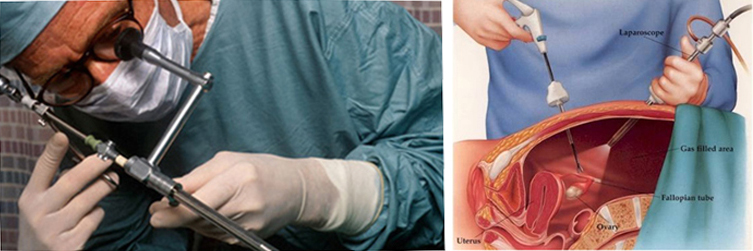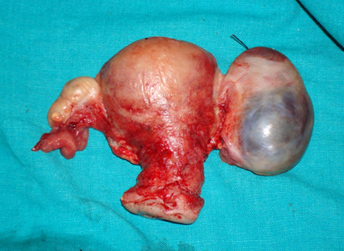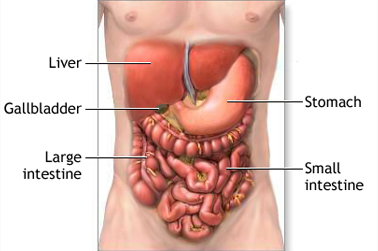What Is a Laparoscopy?
Laparoscopy is a type of surgical procedure that allows a surgeon to access the inside of the abdomen (tummy) and pelvis without having to make large incisions in the skin.
This procedure is also known as keyhole surgery or minimally invasive surgery.
Large incisions can be avoided during laparoscopy because the surgeon uses an instrument called a laparoscope.The laparoscope is a long, thin tube with a high-intensity light and a high-resolution camera at the front. The instrument is inserted through an incision in your abdominal wall. As it moves along, the camera relays images to a video monitor.
Laparoscopy allows your physician to see inside your body in real time, without open surgery.

Figure 1- HOW LAPAROSCOPY IS DONE
Figure 2- LAPAROSCOPY INSTRUMENTS

The advantages of this technique over traditional open surgery include:
When laparoscopy is used
Laparoscopy can be used to help diagnose a wide range of conditions that develop inside the abdomen or pelvis. It can also be used to carry out surgical procedures, such as removing a damaged or diseased organ, or removing a tissue sample for further testing (biopsy).
Various laparoscopic surgeries:

Figure 3- INFLAMMED APPENDIX SEEN IN LAPAROSCOPY
body.

Figure 4- APPENDIX REMOVED AFTER SURGERY

Figure 5- GALL BLADDER AS SEEN IN LAPAROSCOPY

Figure 6- DIAGRAM OF GALL STONES AND CBD STONES

Figure 7 - PROLENE MESH KEPT INSIDE IN LAPAROSCOPIC HERNIA REPAIR (TAPP)

Figure 8- INGUINAL HERNIA AS SEEN FROM INSIDE IN LAPAROSCOPY

Figure 9- UTERUS WITH LEFT OVARIAN CYST AFTER REMOVAL

Figure 10 - UTERUS AS SEEN FROM INSIDE IN LAPAROSCOPY.

Figure 11- DIAGRAM OF ABDOMINAL ORGANS

Figure 12-DIAGNOSTIC LAPAROSCOPY
Diagnostic Uses of Laparoscopy
A laparoscopy often is used to identify and diagnose the source of abdominal or pelvic pain. It usually is performed after other noninvasive options have been tried.
In many cases, abdominal problems are observed with imaging techniques such as:
When these tests cannot provide enough data for diagnosis, a laparoscopy is used to find more details. The procedure also can be used to take a biopsy.
Your physician may recommend laparoscopy to examine the following organs:
By observing these areas with a laparoscope, your physician can investigate:
Administration of Laparoscopy
After changing into a hospital gown, an IV line will be put in your hand or arm.
You will generally be given general anesthesia for this procedure. This means you will sleep through it and not feel any pain. A small incision will be made below your navel. A small tube called a cannula will be inserted. This is used to inflate your abdomen with carbon dioxide gas. Then the laparoscope will be inserted.
Up to a total of four cuts will be made. These allow other instruments to be inserted. For example, your doctor may need to perform a biopsy.
After the procedure is done, the instruments will be removed. Your incisions will be closed with absorbable stitches or surgical tape. Bandages may be placed over the incisions.
Part 4 of 7: Recovery
Recovery from Laparoscopy
When your laparoscopy is completed, you will be observed for several hours before you are released from the hospital. The timing of your release will vary. It depends on:
In some cases, you may have to remain overnight.
Generally, you will be taken to a recovery room. While there, you will be checked for any reaction to the anesthesia or the procedure. Your vital signs will be monitored.
When the effects of your anesthesia wear off, you will be discharged. However, if you received general anesthesia, you will not be permitted to drive yourself home.
After your laparoscopy, you can expect to feel slight pain and throbbing at the surgical sites. Any pain or discomfort should improve daily. Your physician may prescribe medication to relieve the pain.
It is not uncommon to have shoulder pain after your procedure. This occurs when the carbon dioxide gas causes an irritation in your diaphragm, which shares nerves with your shoulder. The carbon dioxide may also cause some bloating.
You will be told not to lift any heavy objects for about a week.
Typically, you can go back to eating your normal diet when you feel hungry.
You usually can resume all normal activities within a week. You will need to return to your physician in about two weeks.